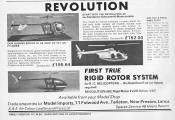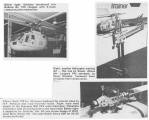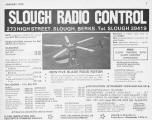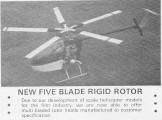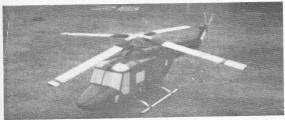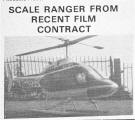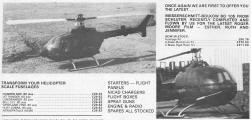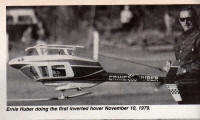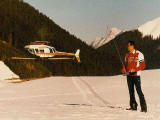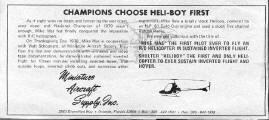RC Helicopter History - 1979
February 79
Second version of the DB Auto-Gyro; fixed rotors with 'aeroplane' controls unlike the machine of Roy Sturman which utilised a full 'helicopter' rotor head. The range of American RC Inc models now expanded for import into the UK to include the Revolution 40 and Hughes 500 variant. Presented at the Nürnberg show was the new Schlüter Bolkow Bo105 and fitted with the System 80 four blade true 'Rigid' Rotor head (first general commercial?). The new model from Graupner the Bell_222 was on display and this also had a Flybarless two blade head which had been developed from the original flybar head of the Bell 212. Kavan also had their version of an 'articulated' helicopter trainer and Alouette 2 with Flybarless conversion as noted below.
Kavan had not been idle and similarly to all the other manufacturers had been developing their Flybarless heads and so in 1979 the control system for the Alouette 2 was given a full 'make over'. From this the model then became available in four versions; two basic kits and their Flybarless options???
- Basic Kit - Fixed pitch
- Conv Kit - Fixed pitch rigid rotor Flybarless
- Basic Kit - Collective pitch
- Conv Kit - Collective pitch rigid rotor Flybarless
Interesting option, a Flybarless fixed pitch machine; not that this hadn't already been tried by Peter Valentine and his conversion of the Micro-Mold Lark. whilst there were benefits of increased cyclic response there was still the problems associated with fixed pitch requiring rotor speed to be varied for height control so it was considered better to have collective pitch for all round performance. Mind you it was a cheap way of getting a better scale look because the flybar was now removed. Note that the Kavan JetRanger though not shown was also now available with a Flybarless head.
Hovering About - Helicopter column in RCM&E by Jim Morley. This month covering the use of his recommended training aid, a piece of string and a helper......???
Lark 2-25 review - Maurice Tait on building and flying the Lark 2-25 from Radio Modeller. Model was well received but reinforced the need for well fixed blades set up with a few degrees of 'lead' in order to stop 'porpoising' (nose oscillations) when slowing down in the circuit.
Futaba FM6 - Radio review Feb 1979. Finally a transmitter with helicopter functions though this test is of the 'Aero' version.
March 79
Slough's own multi-blade head plus advert for their own Lynx helicopter fuselage.
Lark 2-25 review - Bill Burkinshaw on building and flying the Lark 2-25 from RCM&E. Newcomer to helicopters and proved that it wasn't as easy as the instructions made out to fly it but that it could be flown like a plane once in the circuit i.e. 'yank and bank' to turn.
April 79
 US builder Charlie Gilbert and the first 'un-tethered' electric helicopter??
US builder Charlie Gilbert and the first 'un-tethered' electric helicopter??
Hovering About - Helicopter column in RCM&E by Jim Morley. Finally, good advice about what to do once hovering had been mastered, not to try for circuits straight away but to start off with head height small figure eights but keeping the model pointing away from you. The gradually opening up and for bigger eights and landing approaches until you are then actually flying circuits; well done Jim...... First mention of his prototype Sea King model for twin engines and scale five blade head.
May 79
Further info on radios and frequencies plus Sandown report though very little heli information though the Micro-Mold 'Wallis' autogyro was rumoured to 'soon' be available.
June 79
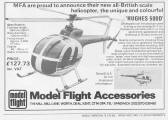
Hovering About - Helicopter column in RCM&E by Jim Morley. Report on TV presentation covering RC models in general and also CB radios. Confirmation that in the UK it was intended to commence a helicopter 'competency' scheme in a similar vein to the fixed wing scheme with a basic 'A' certificate covering safety and the ability to hover followed by a 'B' certificate for general circuit work etc.
July 79
New Schlüter Bolkow Bo105 and four blade head plus Graupner Bell_222 prices which included the Bell Trainer option which had a lightweight Bell 212 body plus the announcement of the soon to be released MM Lark 2-40 plus UK Nationals results.
August 79
 First UK advert for Hirobo helicopters.
First UK advert for Hirobo helicopters.
Hovering About - Helicopter column in RCM&E by Jim Morley. General comments including autorotation and that if the system is developed properly they could be practiced with relative ease. Well we all know that would not quite be true and even with machinery out in 2010 it was still possible to make a 'pigs ear' of it and even by the experts; as proved by many You-Tube video's and even Curtis Yougblood's teaching video.
Breton Fly-in - Report of Helicopter meeting
September 79
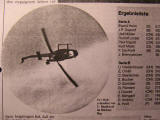 Inverted demonstration flight using 'Invert switch'
Inverted demonstration flight using 'Invert switch'
The first inverted flight demonstration was performed during the "Graupner Challenge Cup 1979" in Lausanne/Switzerland at September 2nd 1979 from Ulrich Baudrexel from Munich, Germany. He used a Graupner Twin-Jet fuselage and built mechanics with a very high positioned motor for a good CG in inverted. Also the pitch range was doubled and the transmitter had a triple switch for reversing pitch, elevator and tail rotor. He flew inverted in forward flight and finished the flight with a half negative loop upwards; no report though of slow or hovering inverted.
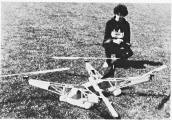 Electric four prop review.
Electric four prop review.
Though a successful prototype, even with the electric technology of the time, it does not appear to have been really followed up until 'unmanned' drones started to appear in the 2000's. Mind you it is not stated that the model did anything other than hover about, I would suspect translational flight could have been interesting.....
Revolution II review - Bill Burkinshaw on building and flying the Flybarless Revolution II from RCM&E. General opinion is that it was for accomplished fliers but could still bite.
October 79
Hovering About - Helicopter column in RCM&E by Jim Morley. General comments on "fly away's" due to radio problems and sometimes despite everything how lucky you can get. Further description of his Sea King twin engine project which had flown and his twin engine Bell 47G which also had flown successfully.
November 79
Slough models range of fuselages, MM Lark 2-40 price and now available.
Inverted hover photos of Ernie Huber and Manfred Heid using an 'invert switch' plus the first 'true' i.e. non-switched continuous inverted flight including prolonged hovering by Mike Mas with a Schlüter Heli-Boy.
December 79
Slough Models advertising the newly released Schlüter four blade head. Dave Nieman Models become the UK importer of Hirobo helicopters.
Hovering About - Helicopter column in RCM&E by Jim Morley. Information on a number of UK fly-ins and competitions held during the later part of the year plus comments on clutch design and more information on his prototype twin engine models.
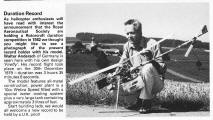 Helicopter duration record holder Walter Andersch.
Helicopter duration record holder Walter Andersch.
Carried out on the 30th December and recorded time of 3 hours, 35 minutes, 6 seconds. 10cc 'marine' Webra engine to allow water cooling so the engine could be set relatively weak in order to aid a low fuel consumption.
Introduced in 1979
 MFA Hughes 500D Schlüter
MFA Hughes 500D Schlüter 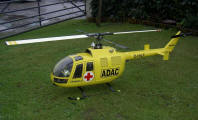 Bolkow Bo105 -
Bolkow Bo105 - 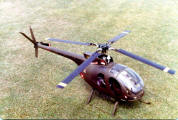 Hughes 500D -
Hughes 500D -
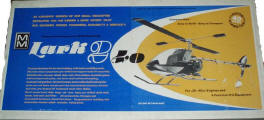
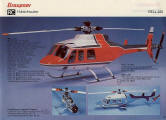 Graupner Bell_222 - Bell Trainer
Graupner Bell_222 - Bell Trainer  American RCH Inc Commander (Year TBC)
American RCH Inc Commander (Year TBC)
Kalt  Bell_222 (year TBC) -
Bell_222 (year TBC) - 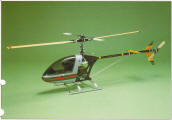 50 Baron (Year TBC)
50 Baron (Year TBC)
Hirobo  Falcon_MK2 -
Falcon_MK2 - 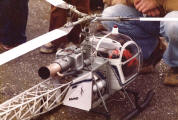 Lama SA-315 (20G)
Lama SA-315 (20G)
Overview 79
First free-flight electric helicopter model though OD and not a commercial venture. Following on from the now successful (relatively) introduction of two blade Flybarless heads by Kavan and Graupner, Schlüter introduces a commercially available multi-blade heads Japanese companies finally appear to be making a move for global sales of their helicopters with Hirobo appearing in the UK with Kalt soon to follow. Futaba bring out a high specification eight channel FM radio with mixers specifically for helicopters and the year of inverted flight; firstly with the use of the 'Invert switch' and more importantly the first instance of 'true' i.e. non-switched continuous inverted flight with hovering by Mike Mas of the USA. Another UK manufacturer begins helicopter production however, though a scale model it was again pitched low regarding technology; whilst this level was required by beginners, competent pilots required high end machines and for these UK pilots had to turn to foreign manufacturers.
Decade overview 70's
The decade started off with the first successful public flight of a RC helicopter and by the end of the decade more than 50 model types from commercial sources and numerous other Own Designs and fuselage kits had been produced. Development had moved from a basic 'fixed' pitch system with just enough control to fly circuits to multi-blade rotor heads with collective pitch control, reliable proven flight performance and the ability to carry out aerobatics plus inverted hovering. However, one thing did remain constant, it was still difficult to learn to fly helicopters. Engine development also matched the pace of helicopter design and could produce reliable power outputs more than capable for the models being produced with a number of manufacturers bring out helicopter 'specific' engines; these tended to focus on increased cooling as this was one aspect that was always difficult to build in to helicopter design. Radio was another area of continual improvement and finally acknowledgement that helicopters required different controls and features compared to 'fixed wing' machines; as such Futaba introduced both 'aero' and 'helicopter' versions of the top of the range transmitter.
Advertising and availability also showed large variations throughout the decade. Initially, due to the rarity of models it was not unusual for a manufacturer to ship their model to all the major countries around the world in order to achieve sales and also to provide direct supply. However, by the mid 70's most countries had their own 'domestic' manufacturers who could produce satisfactory machines for a lot less than foreign competitors and so the worldwide market shrank significantly. By the end of the decade this was to reverse as domestic manufacturers after initial 'home' sales looked to increase their outputs and the only way to do this was to once again go into the export market. It was at this point that the UK manufacturers lacked commercial courage and continued to supply only bottom end trainer machines with the result that the UK was left well behind and in many ways would never catch up for helicopter manufacturing.
Introduced 70's (year still to determine)
Following models are best guess late 70's production.
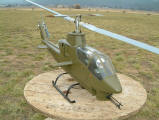 Mantua Cobra
Mantua Cobra 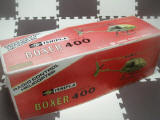 Ishipla Boxer 400
Ishipla Boxer 400


